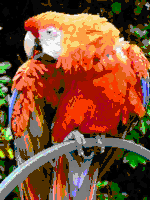List of video game console palettes
- For a full listing of computer's colo(u)r palettes, see List of color palettes
This is a list of the full color palettes for notable video game console hardware.
For color palettes of early 8-bit personal computers, see the List of 8-bit computer hardware palettes article.
For color palettes of 16-bit personal computers, see the List of 16-bit computer hardware palettes article.
For current RGB display systems for 32-bit and better PCs (Super VGA, etc.), see the 16-bit RGB for HighColor (thousands) and 24-bit RGB for TrueColor (millions of colors) modes.
For various software arrangements and sorts of colors, see the List of software palettes article.
For each unique palette, an image color test chart and sample image (Truecolor original follows) rendered with that palette (without dithering) are given. The test chart shows the full 8-bits, 256 levels of the red, green and blue (RGB) primary colors and cyan, magenta and yellow complementary colors, along with a full 8-bits, 256 levels grayscale. Gradients of RGB intermediate colors (orange, lime green, sea green, sky blue, violet and fucsia), and a full hue's spectrum are also present. Color charts are not gamma corrected.
These elements permit study of the color depth and distribution of the full colors of any given palette, and the sample image indicates how the full color selection of such palettes would represent real life images. These images are not necessarily representative of how the image would be displayed on the original graphics hardware, as the hardware may have additional limitations regarding the maximum display resolution, pixel aspect ratio and color placement.
For specific models of videogame consoles, simulations of how the sample image would render in different graphic modes are provided, if available. These simulations are always up to the maximum vertical resolution of the given graphic mode or up to 200 scan lines, if vertical resolution is greater. So any of them could be properly padded, transcoded and dumped into the original hardware and/or software emulators without any other changes.
The sample images only try to show how a certain system is able to handle to an image in terms of color without improvements nor additional clever tricks of design like anti-aliasing or dithering. Doubtlessly a human artist is able to improve enormously the look of the simulated images to approximate them to the original one, but that is not the goal of this article.
Atari
Atari 2600
The Atari 2600 used different YPbPr color palettes dependent on the television signal format used.[1]
NTSC
With the NTSC format, a 128-color palette was available, built based on eight luminance values and 50 combinations of Pb and Pr chroma signals (plus Pb = Pr = 0 for a pure grayscale):
hue / luminance 0 2 4 6 8 10 12 14 0 1 2 3 4 5 6 7 8 9 10 11 12 13 14 15

The hardware supports 4 colors per scanline: a background, an arbitrary 40-pixel wide bitmapped playfield, and colors for the two players. Using just the first two, an NTSC console could draw the above.
PAL
With the PAL format, a 104-color palette was available. 128-color entries were still selectable, but due to changes in color encoding schemes, 32 color entries results in the same eight shades of gray:
hue / luminance 0 2 4 6 8 10 12 14 0,1,14,15 2 3 4 5 6 7 8 9 10 11 12 13

Using just the playfield and background controls, a PAL console could draw the above.
SECAM
The SECAM palette was reduced to a simple 3-bit RGB, containing only 8 colors (black, blue, red, magenta, green, cyan, yellow and white):
0 2 4 6 8 10 12 14
Nintendo
NES
The Picture Processing Unit (PPU) was used in the Nintendo Entertainment System and had a YPbPr 64-color palette , of which nine are duplicates and one is out of NTSC's gamut, giving a total of 54 useful colors. The palette is built based on four luminance values and twelve combinations of Pb and Pr chroma signals (plus two series of Pb = Pr = 0 for eight pure grays). Two of the shades of gray are identical, one has negative brightness, and one is within 2% of another, so sometimes the palette has been reported to have 53 to 55 colors.
In addition to this, it had 3 color emphasis bits which can be used to tint the entire palette any combination of red, green and blue. This extends the total available colors to 432, but inconveniently divided into 8 variations of the base 54. Because it affects the whole palette at once it may be considered more of a filter effect applied to the image, rather than an increased palette range.
Hex Value 0 1 2 3 4 5 6 7 8 9 A B C D E F 00h 10h 20h 30h
The NES could select 4 palettes each containing one of these colors (however, color 0 of each palette has to be the same, so technically, 13 different colors are available at a time) to be applied to the background. A background palette is applied to a 16x16 pixel area, however through a special video mode of the MMC5 mapper it is possible for every 8x8 pixel tile to have its individual palette. As for sprites, 4 different palettes can be used at a time (with color 0 being transparent in each) and every 8x8 or 8x16 pixels can have their own palette, allowing for a total of 12 different colors to use for sprites at any given time.
Because of the constraints mentioned above, converting a photograph often results in attribute clash. Conversions with and without dithering follow, using the hex palette 0F160608 0F162720 0F090010 0F0A1910:
Super NES/SNES
The Picture Processing Unit (PPU) used in the Super NES has a 15-bit RGB (32,768 color) palette, with up to 256 simultaneous colors at once.
However, while the hardware palette can only contain 256 entries, in most display modes the graphics are arranged into between 2 and 4 layers, and these layers can be combined using additive or subtractive color blending. Because these blended colors are calculated by the hardware itself, and do not have to be represented by any of the existing palette entries, the actual number of visible colors onscreen at any one time can be much higher.
The exact number depends on the number of layers, and the combination of colors used by these layers, as well as what blending mode and graphical effects are in use. In theory it can show the entire 32,768 colors, but in practice this is rarely the case for reasons such as memory use. Some title screens use 256-color mode, but gameplay most often uses a 4-bit layer, with one of eight 15-color palettes assigned to 8x8 pixel areas of the background.
From left to right: theoretical 32768 color palette; practical 256 out of 32768 color palette
Game Boy
The original Game Boy uses a monochrome 4-shades palette. Due to the fact that the non-backlighted LCD display background is greenish, this results in a greenscale graphic display, as it is shown in the simulated image (at Game Boy display resolution), below.
The Game Boy Pocket uses a monochrome 4-shades palette using actual gray. It resembles the Left+B palette of the Game Boy Color (see below).
Game Boy Color
The Game Boy Color systems use a 15-bit RGB (32,768 colors) palette.
When an older monochrome original Game Boy game cartridge (Type 1) is plugged-in, if certain combinations of the controls are held during startup (or if the game is recognized from a hard-coded list in the device's ROM), the games are colorized with one of the factory 12 false color palettes. In this mode, games can have from 4 to 10 colors, due 4 are for the background plane palette and there are two more hardware sprite planes palettes, with 3 colors plus transparent each.
The following shows these startup palettes (background plus both sprite planes) and the combination of controls used (the names are taken from the Game Boy user's manual; the colors are simulated):

UP (Brown)
UP+A (Red)
UP+B (Dark brown)
DOWN (Pastel mix)
DOWN+A (Orange)
DOWN+B (Yellow)
LEFT (Blue)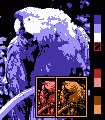
LEFT+A (Dark blue)
LEFT+B (Gray)
RIGHT (Green)
RIGHT+A (Dark green)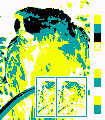
RIGHT+B (Reverse)
The specific Game Boy Color (Type 3) game cartridges presents up to 56 colors without the use of special programming techniques from the full 32,768. From these, 32 are for a background palette, plus 8 hardware sprite palettes, with 3 colors plus transparent each. Typically, the sprite palettes shares some colors (black, white or others), so the total colors displayed are less than 56.
Here is the sample image shown in the non-backlighted color LCD display of the Game Boy Color (the colors are simulated):
Though there is a 56 color limit, this in of itself is a palette storage limit and not an actual hardware limitation. As such, the programmer can swap out the palettes on a per-scanline or even on a mid-scanline basis ("mode 3 mid-scanline rendering"). Because of this ability to swap out the palettes each scanline, over ten thousand colors can actually appear on screen per frame when programmed on a per-scanline basis.
Game Boy Advance
The Game Boy Advance/SP/Micro systems also uses a 15-bit RGB palette, and along with the original and Color modes, they have also a specific Highcolor 32,768 colors mode.
In addition, the LCD displays of the Micro and some models of the SP are backlit, giving brighter images.
Here are sample images shown simulating a backlit color LCD display of the Game Boy Advance/SP/Micro in both Game Boy Color compatible mode and Game Boy Advance 32K color mode:
Sega
Master System
The Master System had a 6-bit RGB palette (64 colors), with 32 colors on-screen at once. It is possible to display all 64 colors at once using raster effects (line interrupts).
There are only 512 different 8x8 tile patterns to cover the screen though, when 768 would be required for a complete 256x192 screen. This means that at least 1/3 of the tiles will have to be repeated. To help maximize tile reuse, they can be flipped either vertically or horizontally. The 64 sprites of 8x16 pixels can also be used to help to cover the screen (max 8 per scanline).
Because of the constraints mentioned above, there are no current simulated screen images available for the Sega Master System.
Game Gear
The Game Gear had a 12-bit RGB palette (4096 colors), with 32 colors on-screen at once.
Mega Drive/Genesis
The Mega Drive/Genesis used a 9-bit RGB palette (512 colors, 1536 including shadow and highlight mode) with up to 61 colors on-screen at once without raster effects (4 palette lines of 16 colors each, palette indices $x0 are definable but considered as transparent, and can only be used as the background color).
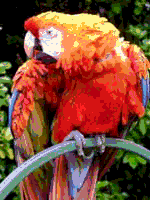
NEC
TurboGrafx-16
The TurboGrafx-16 used a 9-bit RGB palette, like the Mega Drive/Genesis, consisting of 512 colors with 482 colors on-screen at once (16 background palettes of 16 colors each, with at least 1 common color among all background palettes, and 16 sprite palettes of 15 colors each, plus transparent which was visible as the overscan area).
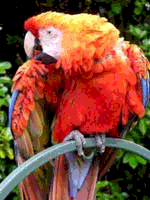
See also
- List of 8-bit computer hardware palettes
- List of 16-bit computer hardware palettes
- Palette (computing)
- Indexed color
- Colour look-up table
- Color depth
- Computer monitor
- List of home computers by video hardware
References
- ↑ Atari 2600 "TIA color chart". Archived February 12, 2011, at WebCite








